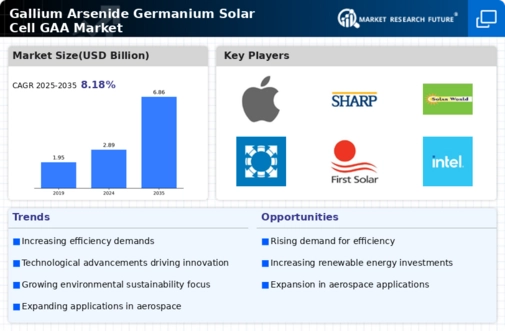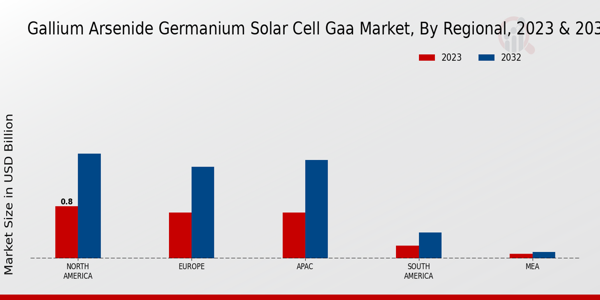Market Growth Projections
The Global Gallium Arsenide Germanium Solar Cell GAA Market Industry is projected to experience substantial growth over the next decade. With an anticipated market value of 2.89 USD Billion in 2024, the industry is set to expand significantly, reaching an estimated 6.86 USD Billion by 2035. This growth trajectory is supported by a compound annual growth rate (CAGR) of 8.17% from 2025 to 2035. The increasing adoption of renewable energy technologies, coupled with advancements in solar cell efficiency and performance, positions the GAA solar cell market as a key player in the global energy landscape. This upward trend reflects the broader commitment to sustainable energy solutions.
Technological Advancements
Technological innovations in the Global Gallium Arsenide Germanium Solar Cell GAA Market Industry are enhancing the efficiency and performance of solar cells. Recent developments in materials science and engineering have led to the creation of high-efficiency GAA solar cells that outperform traditional silicon-based cells. For instance, the integration of advanced manufacturing techniques has reduced production costs while improving energy conversion rates. This progress is crucial as the market anticipates a growth trajectory, with projections indicating a rise to 6.86 USD Billion by 2035. The continuous evolution of technology not only boosts competitiveness but also attracts investments, further propelling the market forward.
Global Energy Security Concerns
Concerns regarding global energy security are propelling the Global Gallium Arsenide Germanium Solar Cell GAA Market Industry forward. As geopolitical tensions and supply chain disruptions become more prevalent, countries are seeking to diversify their energy sources and reduce reliance on fossil fuels. Solar energy, particularly through advanced technologies like GAA solar cells, offers a viable solution to enhance energy security. By investing in domestic solar production, nations can mitigate risks associated with energy imports. This strategic shift is expected to contribute to the market's expansion, as countries prioritize energy independence and sustainability in their energy policies.
Government Incentives and Policies
Government incentives and supportive policies are significant drivers in the Global Gallium Arsenide Germanium Solar Cell GAA Market Industry. Many countries are offering tax credits, grants, and subsidies to encourage the adoption of solar technologies. For example, the United States has implemented various federal and state-level incentives that stimulate investment in solar energy projects. These initiatives not only lower the financial barriers for consumers and businesses but also create a favorable environment for manufacturers. As a result, the market is expected to grow at a CAGR of 8.17% from 2025 to 2035, reflecting the positive impact of these policies on the GAA solar cell sector.
Rising Demand for Renewable Energy
The Global Gallium Arsenide Germanium Solar Cell GAA Market Industry is experiencing a surge in demand driven by the global shift towards renewable energy sources. Governments worldwide are implementing policies and incentives to promote solar energy adoption, aiming to reduce carbon emissions and combat climate change. This trend is particularly evident in regions such as Europe and North America, where ambitious renewable energy targets are set. The market is projected to reach 2.89 USD Billion in 2024, reflecting the increasing investment in solar technologies. As countries strive for energy independence and sustainability, the GAA solar cell technology is likely to play a pivotal role in meeting these objectives.
Increasing Energy Efficiency Standards
The Global Gallium Arsenide Germanium Solar Cell GAA Market Industry is influenced by the rising energy efficiency standards mandated by governments and regulatory bodies. As energy consumption continues to rise, there is a growing emphasis on improving energy efficiency across various sectors. This trend is particularly pronounced in the construction and automotive industries, where energy-efficient solutions are increasingly required. GAA solar cells, known for their superior efficiency, are well-positioned to meet these standards. The demand for high-performance solar solutions is likely to drive market growth, as industries seek to comply with regulations while reducing operational costs.























